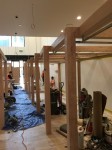Stress, anxiety, and pain can dramatically restrict anyone’s lifestyle and negatively affect their overall health. Take care of yourself. Research on the benefits of massage therapy gives strong evidence for including massage as part of an approach to staving off pain and relieving stress and anxiety.
Stress
Anyone who has ever had a massage to relax knows its effect, but research shines a light on the science behind what takes place during massage. For more than 20 years, studies have shown some of the positive effects of massage therapy for relaxation. In a study on the effect of trigger point therapy1, there was a significant decrease in heart rate, systolic blood pressure8, and diastolic blood pressure8. Measures of oxygen consumption, blood pressure, and salivary cortisol levels were all lower after a 10 to 15 minute chair massage in controlled studies.2, 3, 4 Changes in psychological states have been measured by physiological responses1, 3, the Perceived Stress Scale5,6, the POMS Depression Scale4,5, and the Anxiety State Scale.4
Anxiety
Research continues to document the impact for relief of anxiety and depression for people in a wide range of health situations.8, 9, 10, 11 For example, one randomized study found women with stage 1 and stage 2 breast cancer benefited from regular massage therapy sessions. The immediate massage benefits included reduced anxiety, depressed mood and anger, while the long-term impact reduced depression and increased serotonin values. Serotonin, a neurotransmitter with functions in various parts of the body, works to regulate mood, appetite, sleep, memory and learning.
Pain
From the muscle strain and soreness when you overdo it to serious or chronic pain, massage therapy is showing positive results. Consumers are learning its value, as 41 percent of American adults who had a massage in the past five years indicate they sought it for pain relief.12
A meta-analysis of research on massage therapy for pain conducted by Samueli Institute in 2016 concluded that massage therapy should be strongly recommended for pain management. The analysis reviewed 67 published studies on the impact of massage therapy on pain.13
References
1. Delaney, J.P., Leong, K.S., Watkins, A., & Brodie, D. (2002). The short-term effects of myofascial trigger point massage therapy on cardiac autonomic tone in healthy subjects. Journal of Advanced Nursing, 37, 364-71.
2. Boone, T., Tanner, M., & Radosevich, A. (2001). Effects of a 10-minute back rub on cardiovascular responses in healthy subjects. American Journal of Chinese Medicine. 29, 47-52.
3. Cady, S. H., & Jones, G. E. (1997). Massage therapy as a workplace intervention for reduction of stress. Perceptual & Motor Skills, 84, 157-158.
4. Field, T., Ironson, G., Scafidi, F., Nawrocki, T., Goncalves, A., Burman, I., Pickens, J., Fox, N., Schanberg, S., & Kuhn, C. (1996). Massage therapy reduces anxiety and enhances EEG pattern of alertness and math computations. International Journal of Neuroscience, 86, 197-205.
5. Brennan, M.K. & DeBate, R. (2004).The effect of chair massage on stress perception of hospital bedside nurses. Massage Therapy Journal 43, (1), 76-86.
6. Field, T., Quintino, O., Henteleff, T., Wells-Keife, L., & Delvecchio-Feinberg, G. (1997). Job stress reduction therapies. Alternative Therapies in Health and Medicine, 3, (4), 54-56.
7. MacDonald, G. (1998). Massage offers respite for primary care givers. The American Journal of Hospice & Palliative Care, Jan/Feb, 43-47.
8. Jane, S.W., Wilkie, D.J., Gallucci, B.B., Beaton, R.D., Huang, H.Y. (2009). Effects of a Full-Body Massage on Pain Intensity, Anxiety, and Physiological Relaxation in Taiwanese Patients with Metastatic Bone Pain: A Pilot Study. J Pain Symptom Manage. 37(4):754-63.
9. Imanishi, J., Kuriyama, H., Shigemori, I., Watanabe, S., Aihara, Y., Kita, M., Sawai, K., Nakajima, H., Yoshida, N., Kunisawa, M., Kawase, M., Fukui, K. (2007). Anxiolytic Effect of Aromatherapy Massage in Patients with Breast Cancer. Evid Based Complement Alternat Med.
10. Smith, M., Reeder, F., Daniel, L., Baramee, J., Hagman, J. (2003). Outcomes of touch therapies during bone marrow transplant. Alternative Therapies in Health and Medicine, 9(1) 40-49.
11. Hughes, D., Ladas, E., Rooney, D., Kelly, K. (2008). Massage therapy as a supportive care intervention for children with cancer. Oncol Nurs Forum, 35(3):431-42.
12. American Massage Therapy Association annual consumer survey conducted by ORC International, July 2017.
13. Crawford C, Boyd C, Paat C, et al. The Impact of Massage Therapy on Function in Pain Populations – A Systematic Review and Meta-analysis of Randomized Controlled Trials: Part I, Patients Experiencing Pain in the General Population. Pain Medicine, first published online: 10 May 2016.
Article from AMTA, see www.amtamassage.org


















